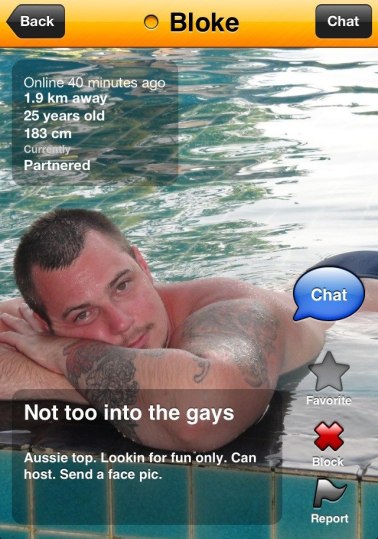Grindr started out as a geosocial networking app specific for gay, bisexual, and bi-curious men, but it has become so much more in the LGBTQ community since its release back in 2009. Grindr uses the GPS system embedded in smartphones to connect with other Grindr users based on your location. After 4 years, Grindr has become the most popular all-male location-based social network with 4 million users in 192 different countries around the world. The app is still growing with about 10,000 new users downloading the app every day (Grindr, 2013).
Some Grindr users, however, have taken this social app to a different level. While some users still genuinely look for friendships or even true loves on the app, most users use it as a “hook-up” app, where you can find someone you’re attracted to or is attracted to you without having to even leave your apartment. All you need to do is go on the app and start chatting. If you find someone like-minded, you can go for a drink or go straight to the bedroom. With this kind of fast food-like hookup lifestyle, it comes as no surprise that some users’ biography becomes a little forward in terms of criteria for chatting with them in order to get straight to the point in terms of what they are looking for, and this is where the internalized hatred within the LGBTQ community comes in.
The following are a few examples:
(Photo credit: http://stopracismandhomophobiaongrindr.wordpress.com/tag/grindr/)
The first picture’s bio reads: “Masculine guys only NO Fairies thanks. Would be nice to meet a decent guy 4 a change.Lol.Where has all the romance gone?” In The Limitations of the Discourse of Norms – Gay Visibility and Degrees of Transgression, Jay Clarkson discusses the internal discrimination within the gay community by introducing ActingStraight.com, a website created by “straight-acting” gay men who “seek to normalize a particular set of gender performances as acceptably gay, and the expense of other performances perceived as more transgressive” (Clarkson, 2008). They believe that gays need to act straight-like in order to be more accepted and more welcomed while flamboyant gays become a stereotype of the gay community that ultimately hurts the progression of homosexuality acceptance in the society.
They are wrong in many ways. One, this messaging implicitly suggests that they also believe the acceptance of their own gender identity is more important than the overall acceptance of the entire LGBTQ community. They are willing to sacrifice other LGBTQ members’ social acceptance for their own, forcing them to act a certain way because ultimately, they benefit from this homosexuality normalization. Secondly, more media representation and visibility of masculine gay and bisexual men will not positively correlate to “straight-acting” LGBTQ members’ social power. Almost-naked young white women would run the Western culture if media visibility translates directly and positively into social empowerment (Phelan, 1993, p.10).
The second profile’s headline reads, “not too into the gays.” Again, being on a gay and bi social network app, this user still feels the need to separate himself from the rest of the users because he is “not too into the gays,” putting the rest of the gay community below him. This shows how the hegemonic ideology, where the society generally teaches and celebrates heterosexuality, is still taught and celebrated within the LGBTQ community. If you are straight acting, that is good because you follow the heterosexual hegemonic ideology. If you are flamboyant, that is bad because you challenge the society’s teachings and acceptance. What this Grindr user fails to realize is that his actions feed to homophobia both from the society and within the LGBTQ community. By condemning a certain group within the LGBTQ community, this user actually becomes a contribution for the lack of homosexuality acceptance.
The third profile says, “if you need to have weird wrist movements or talk with a chicks voice keep on prancing fairy.” The weird wrist movement refers to a specific feature of some flamboyant boys. Again, this profile is an example of how “selective homophobia is alive and well within gay communities. It suggests that some gay men feat the gender performances they see as flaming, not only because they do not like them, but also because they fear what those performances may mean to straight people” (Clarkson, 2008). This describes how influential the hegemonic ideology is on the society, that even within the LGBTQ community, there is still a hierarchy where if you’re as close to being heterosexual as possible, you still have a higher social status. This also means that flamboyant gays still “remain among the most marginalized members of society,” where even within a lower social-acceptance class, they are still viewed as undesirable or as non-hegemonic ideal.
What started out as a friendship kindling and love finding social app ends up feeding back into internalized homophobia within the gay and bisexual men community, Grindr serves more than an app but a social norm to the community. Therefore, Grindr has the responsibility to influence the LGBTQ community, acknowledging that some of its users may be contributing to homophobia in ways they do not even know.
Bibliography
Clarkson, J. (2008). The limitations of the discourse of norms: Gay visibility and degrees of transgression. Journal of Communication Inquiry, 32(4), 368-382. Published by Sage Publications, Inc.
Gindr (n.d.). Retrieved from http://grindr.com/
Phelan, P. (1993). Unmarked: The politics of performance. London: R



